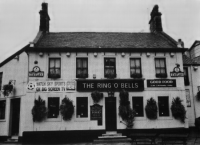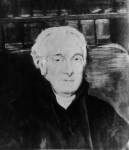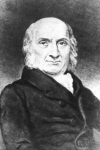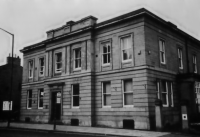The Bradford Canal - The First Promoters
John Allison
(First published in 1999 in volume 7, pp. 3-15, of the third series of The Bradford Antiquary, the journal of the Bradford Historical and Antiquarian Society.)
On the 15th of January 1771 a meeting was held in Bradford. It took place in the Sun Inn which stood at the bottom of Ivegate where the present Prudential Assurance Building (the red terra-cotta faced building between Ivegate and Sunbridge road) now stands. The Sun Inn was a well-known place where important decisions were taken regarding the future of Bradford and the surrounding area. At that time Bradford was a very small town, little larger than a village, and there were no public buildings; meetings were held in the town's public houses. A few years earlier the idea of building the great cross-country canal, the Leeds and Liverpool, was mooted in the Sun Inn but, this meeting in early 1771 was to form a company and gain promises of the necessary capital to build the Bradford Canal to run from the bottom of Church Bank to Windhill, which at that time was part of the township of Idle. Fourteen people agreed to the building of a navigable cutt or canal to join the Leeds and Liverpool Canal. In time, through the Industrial Revolution, this would cause the transformation of the pretty, rural, eighteenth-century town of Bradford into the thriving, but smoky, grimy and over-crowded, worstedopolis of the nineteenth century. The first entry in the minute book of the Bradford Canal Company states:1
Bradford 15th January 1771
Whereas an Act was obtained Last Session of Parliament for making and maintaining a Navigable Cutt or Canal from Leeds bridge in the County of York to the North Lady's Walk in Liverpool in the County Palitinate of Lancaster and from a place in the Township there to the river Mersey Now we whose names are hereunto put Do hereby agree to Advance and Pay into the hands of Mr. John Hustler of Bradford in the County of York Merchant and Mr. Thomas Crosley of the same place merchant the several sums gott opposite to our several and respective names Towards making and maintaining a navigable Cutt or Canal from Bradford to Adjoin to and communicate with the said Cutt or Canal from Leeds to Liverpool at of Idle in the County aforesaid under the Direction of a Committee to be appointed by the subscribers or the major part of them.
| Abm. Balm for Miss Hodgson | £1000 |
| Ditto for himself | £600 |
| John Field | £400 |
| Josa Field | £300 |
| Natn Jowett | £100 |
| John Hustler | £200 |
| Tho Hardcastle | £100 |
| Wm Hardcastle | £100 |
| Joshua Walker | £100 |
| Ditto for Eliza. Walker | £100 |
| Jn & Wm Atkinson | £100 |
| C.S.B.Sharp | £500 |
| John Buck | £200 |
These people were the first to agree to provide money - £3,800 - to build the Bradford Canal. More money would be required, the Act said that £6,000 must be raised, or promised, before the work could begin, but who were these people who offered to provide capital at the first meeting?
Miss (Mary) Hodgson was a relation of Abraham Balme who acted as her steward. The Jowett family were also business friends of hers. She owned land at Wilsden, and in 1791, twenty years after she put up the largest amount, £1,000, to construct the Bradford Canal, she leased land at Hewenden to William Nichols of Farsley and John Barker. They erected a worsted spinning mill in 1792 driven by water from the Harden Beck. This mill" estimated at 10 horse-power, was probably the third power driven (using water or steam) mill in the area.2 The first was built at Addingham in1778 and was water driven. The second, at Tong Park, Baildon, was built in 1787 and converted to steam in 1796, becoming the first steam-powered spinning mill in West Yorkshire.3
Abraham Balme was born in 1706, the eldest son of a Thornton yeoman farmer. There was a branch of the Balme family in the Tyersal/Tong area, but originally they are believed to be of French Huguenot stock, well-known as weavers, who fled from persecution to England. Abraham farmed and leased his estates which increased as a result of his two marriages. He also bought land at Bowling and Oxenhope and benefited from the spate of common-land enclosures which took place in the Eighteenth century. As a result of enclosures he gained more than 70 acres at Oxenhope and 24 at Thornton. By 1760 he had a large estate at Bowling and from 1753 to 1766 he was land steward to Thomas Pigot of Bowling Hall, Lord of the Manor of Bowling. During this period he began to exploit the minerals of the Bowling estate, organising the mining at one of Pigot's pits and leasing mines to others. He was also interested in improving the road communications in the area. He was a trustee in turnpike trusts including the Leeds to Halifax Turnpike which passed close to the Bowling mines. In 1753 there was a reaction against turnpikes, the "Rebecca Riots" so called because the rioters dressed as women in an attempt to hide their identities. In June of 1753 mobs destroyed toll-houses and turnpike property at Bradford Moor, Apperley Bridge, Tyersal Moor End, Newall Hall, Wibsey Bank Foot and Bradford "At last, they beset Mr Balme's house, and behaved in a very irregular and unseemly manner".4 Abraham Balme had interests in the limestone and coal trade in Craven. He was a partner in the limekiln company at Northbrook, near to the Bradford Canal basin.
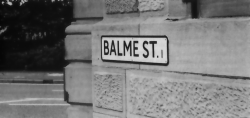
Balme acted as trustee for his distant relation Mary Hodgson. He was her scrivener (an early type of banker) and cashed and changed bills of exchange on his own behalf. Leach, Pollard and Hardcastle, the first bank established in Bradford, was used for some banking and credit transactions but his main central bank was Smith, Payne and Smith of London. He stopped his money-lending business and banking activities in 1780. This was well-timed as the recession caused by the American War of Independence resulted in the bankruptcy in 1781 of the Leach, Pollard and Hardcastle bank.5 Balme was closely involved in the building of the Leeds and Liverpool Canal and acted for both that and the Bradford Canal as land buyer and valuer. He served on the first committee of the Leeds and Liverpool Canal Company and his descendant, Wheatley Balme, was still on the committee at the beginning of the twentieth century.
Abraham Balme died in 1796 aged 90. He is commemorated in Bradford Cathedral by a white marble tablet carved by John Flaxman R.A. which shows an old man reading from a book to a youth and a maiden under the title Instruct the Ignorant. Balme Street, between Canal Road and Bolton Road, near Forster Square, which crosses the old route of the canal, was named after him. Abraham lived in a house he built at the bottom of Bolton Road, overlooking the canal basin, which is now the Ring of Bells public house.
John Field lived at Heaton Hall, believed to have been built in 1660. It was demolished in 1939 and was on a site which is now occupied by St. Bede's School.6 He came from an old Heaton family and owned much land. He was born in 1701 and came into the estate on the death of his uncle Joseph in 1733. He married, Mary, the youngest daughter of Joshua Eamondson of Seacroft. John was involved with Abraham Balme, John Hustler and Thomas Hardcastle in the Toller Lane, Haworth and Blue Bell turnpike trust. This ran from Heaton to the Blue Bell Inn at Two Laws near Come. John Field had an only son, Joshua - the next name on the Canal Company's first minutes - who succeeded him when he died in 1772.
Joshua Field was born in 1772. He married, at Scarborough in 1774, Mary the youngest daughter but eventually the sole heiress of Randal Wilmer of Helmsley of the ancient family of Thwenge. Joshua died in 1819 leaving five children.7 Joshua's eldest son, John Wilmer Field B.A., born in 1775, was a magistrate and had served in the Royal Horse Guards, Blue Regiment. He married twice, firstly in 1812, to Anne the daughter of Robert Wharton Middleton of Grinklepark in Cleveland who bore him two daughters, Mary and Delia. His second wife was Isabella Helena Salter daughter of a Royal Navy Captain. They had no children. In 1836 Delia Field married the Honourable Arthur Duncombe of the Feversham family who later became an admiral.
Nathan Jowett also lived where a Bradford school is now located. He lived at Clockhouse in Manningham part of whose grounds is now the site of Bradford Granunar School. Nathan was the son of another Nathan and Mary Booth who married in 1731. Our Nathan married his cousin Mary Jowett of Knaresborough in 1760 and inherited Clockhouse in 1774 from his uncle Samuel who had bought the property for £1,420 in 1743 when he was described as "of Eccleshill, gentleman". Nathan was an enclosure commissioner and acted during the enclosures of Idle, Thwaites (Keighley), and Riddlesden. He built up large land holdings which he left to his son, also Nathan!, who was a barrister. The estate passed through female descendants to George Baron of Leeds, who was a wealthy landowner in his own right. George Baron's heir was unmarried and when he died the estate was willed to the descendants of the siblings of the Samuel Jowett who originally bought Clockhouse. This large estate consisting of 145 farms and £8,000 per year income was inherited by a descendant of our Nathan's aunt, Susanna, who had married a John Atkinson in 1725. The man who inherited this huge estate was also called Nathan, but, of course, his surname was Atkinson. He was a farmer and milkman living in Bolton (Bradford) and after he inherited he added Jowett to his surname. Nathan Atkinson Jowett's right to the property was disputed by a member of the Jowett family in Idle who at least had the surname of Jowett. This was Joseph Jowett, known as "Doze". The Clockhouse case, as it was known, involved Doze borrowing money from friends to contest the will. He offered large interest and many people lent him money, some their life-savings. The case lasted for six years but Doze lost and his backers never saw their money again.
The Atkinson-Jowett family owned vast areas of land in Bradford as well as in other parts of Yorkshire. They lived at Clockhouse and continued to develop their estates and bought land in Ecc1eshill, Bolton and Idle amongst other places. The land used for Swaine House Estate was bought by the Corporation for housing purposes from the Akinson-Jowetts. Nathan's son, James, built Grove House in 1860 which was reached by a carriage drive from Bolton Road. This is the site which was used to build another school - Grove House First School off Myers Lane.
Clockhouse still stands in the present grounds of Bradford Grammar School.
John Hustler was probably the one man whose influence changed Bradford from a village to a large city. A city which was to become the world centre of the wool textile industry. He was born in 1715. His parents were the Quakers William and Jane Jowett (a relation of Nathan Jowett, the previous signatory) of Apple Tree Farm, Low Fold, Bolton. His father was a wool merchant as well as a farmer and John served an apprenticeship as a woolsorter and stapler. The family business flourished during the 1740's and John must have built-up his contacts as he represented the local merchants in the marked-wool controversy in 1751. As a result of the Worsted Acts he helped found the Yorkshire Worsted Committee, becoming its first chairman. This organised a system of inspection and supervision to prevent malpractices, fraud and embezzlement. With the putting-out system it was fairly easy for short measures at each stage in the manufacturing process to amount to large losses for the merchants. The committee tried to prevent the export of raw wool and was also an early manufacturers' association opposed to textile workers setting up trade unions. The wool merchants wanted the freest conditions to allow the industry to grow and flourish. The committee subsidised inventors of new machinery and officially thanked John for his services in 1778.8

Hustler proposed the building of the Bradford Piece Hall which he and a group of merchants built in Kirkgate opposite the bottom of Piccadilly. He was a prime-mover in opening out Bradford centre and suggested the building of New (now Market) Street. John was involved in turnpikes with Balme and Field.
When John Stanhope died in 1770 Hustler took over the role of leading promoter of the Leeds and Liverpool Canal, writing a pamphlet A Summary View of the Proposed Canal to maintain the interest of potential backers. He was instrumental with Balme in buying land for the Leeds and Liverpool and Bradford Canals. He owned local collieries and invested in collieries at Orrel and Upholland near Wigan which were to prosper through access to the Liverpool coal market opened up by the Leeds and Liverpool Canal.9 He supplied coal from his local pits to the Northbrook limekilns. John Hustler lived at Bolton Hall, part of whose grounds became Peel Park.10 He built Undercliffe House, which stood where the grounds of the present Carlton-Bolling School are. The house was probably built just before he married, in 1763, Christiana, also a Quaker, the daughter of William Hird of Apperley. He formed a wool stapling partnership with Edmund Peckover who had a later partnership, Peckover, Harris and Company, which became Bradford Old Bank. He had other connections with banking through his Quaker contacts in Norwich. His second son, also John (born January 31st 1771), married, firstly, Elizabeth the sister of the Quaker Edward Pease of Darlington, secondly, Mary the daughter of Daniel Mildred who was a Quaker banker in London and this son was involved in the Peckover, Harris and Co. bank. Another of John's sons was a leading botanist and noted farmer in his day. It is said that he was the first person to use bone-meal as a fertiliser.
John Hustler took in virtually all the Eighteenth century changes which resulted in the leap-forward we call the Industrial Revolution. He was a religious revolutionary, being a Quaker; his involvement in lime assisted the agricultural revolution; he was instrumental in the revolution in transport, both road, through turnpike development, and water, playing key roles in both the Leeds and Liverpool and Bradford Canal projects. He was in at the beginning of banking and his activities in coal-mining, lime production and wool merchanting made him a leading industrial pioneer. He was perhaps too old and too late to take an interest in the engineering developments in the area but he paved the way for Messrs. Preston, Hird, Jarret, Hardy, Dawson, Leah, Paley and others to make huge successes of the Low Moor and Bowling Ironworks. As Gary Firth says in Bradford and the Industrial Revolution, "Hustler, in the period 1766 to 1782 had provided for the Bradford manufacturer and merchant, an institutional framework within which the progress of the worsted trade was developed and co-ordinated by its numerous entrepreneurs.".11 He died in 1790 and is buried in the Friends' Burial Ground in Barkerend.12 He is remembered in Hustlergate in the City centre and Hustler Street off Undercliffe Old Road.
Thomas Hardcastle is more elusive and it is harder to discover much about him. A reference in the Jowett papers dated 27th November 1773 states a Thomas Hardcastle was "of Bradford, salter"13. Horace Hird in Bradford Remembrancer says that he was involved in 1755 in the Blue Bell turnpike trust with Balme, Hustler, Field and others14 and Firth states that a Thomas Hardcastle was active in the Worsted Committee in Bradford and Horton, and also describes Thomas as a banker when in 1769 he was appointed one of the treasurers of the Leeds and Liverpool Canal Company.15 Maybe he was the brother of the next signatory.
William Hardcastle was a partner in the first Bradford bank of Leach, Pollard and Hardcastle which used part of Hardcastle's warehouse in Well Street. It appears that William was also a wool merchant. He was married to Pollard's sister and Pollard is also described as a woolstapler. William is described in the Jowett papers as "of Bradford bankers".16 A William Hardcastle is described by Firth as a coal merchant (in other words a coal-mine owner) and a shareholder in the Bradford Limekiln Company.17 The Leach, Pollard and Hardcastle bank appears to have been in existence in 1760 but it failed in 1781.
Joshua Walker was born in 1746 in one of a pair of "respectable dwellings" known as Sundial House and Prospect House in Wakefield Road. Sundial House belonged to Joshua's father, also called Joshua, a Quaker apothecary. Joshua senior had bought land in 1741 to build Upper House which was on a site near to where the old Bowling Police Station stands.
Joshua junior was educated at the Grammar School and then trained in medicine with the Quaker David Hall at Skipton. Afterwards he continued his studies in Edinburgh to gain his M.D. Dr Walker began his medical practice in Hull, but moved to Leeds where he served for twenty-five years at Leeds Infinnary. In 1784 he wrote a paper On the Mineral Waters of Harrogate and Thorpearch and it was said that he had "a natural talent for poetry and a taste for polite literature".18 He inherited his father's estate, except for Upper House which was given to his sister Elizabeth. Doctor Walker married Mary, only daughter of John Arthington who was a Leeds brewer. They had two daughters. Of his first daughter's children, two sons became M.P.s for Wakefield and Huddersfield respectively. A daughter, Margaret, married the Right Honourable John Bright, M.P. for Central Birmingham and another daughter married Samuel Gurney Barclay, banker, of London.
Doctor Walker died in 1817.
Elizabeth Walker was Doctor Joshua Walker's sister. She married John Robinson of Semerdale House near Askrigg. Her only son, John, married and lived for some time at Eccleshill Hall but died at Semerdale House. He had several sons and daughters, one of whom married Greenwood Bentley, jun., of Bradford, who was a solicitor.19
Jn. & Wm. Atkinson were the father and son better known as Johnson Atkinson Busfield and William Atkinson Busfield. Johnson married Elizabeth Busfield and added Busfield to his surname in 1772 when his wife inherited her uncle Thomas's estate.
Johnson bought land in Bingley in 1767 and in 1772 built Myrtle Grove which became the Bingley Town Hall behind the Bradford and Bingley Building Society head office. Because of debts he sold Myrtle Grove in 1805 to General Twiss, a veteran of the American War of Independence. Johnson was a trustee, with Joshua Field, of the Bradford to Keighley turnpike. In 1819 they completed a new section of the turnpike road from Cottingley Bar (named after the toll-booth which was moved there from Cottingley Bridge in 1823) to Shipley and Bradford. The old road going to Bradford from Cottingley over the hill to Haworth Road was still retained.
Johnson was a member of a group which owned Castlefield Mill in Bingley. He paid for the restoration of Bingley Church and gave the bells, but he also played host to John Wesley who stayed at Myrtle Grove which he described as a "little paradise". After the disturbances in Lancashire over the use of water-powered machinery he tried to form a company of volunteers but the government refused his offer. Later when the Bradford Volunteers (known as Ready and Steady from the motto on their buttons) were formed in 1794 J.A. Busfield became their Lieutenant Colonel. Johnson died in 1817 and his son, William, in 1851.
C.S.B. Sharp was born plain Charles Booth the son of the Reverend Charles Booth. His mother was the daughter of Mr William Swaine of Bradford. Charles Booth was a barrister-at-law. His aunt, Miss Swaine, who lived in a "good house standing at one time in Hall Ings",20 died in 1759 and left her fortune to Charles and he changed his name to Charles Swaine Booth. In 1769 Charles married Hannah Gilpin who had added Sharp to her own name two years earlier when she had inherited Abraham Sharp's estate. Abraham Sharp was a mathematician and scientist and he lived and worked at Horton Old Hall which existed until the 1960's when it was demolished to make way for the car-park serving St. Luke's Hospital. Abraham's estate passed to his niece who had married Robert Stansfield of Esholt. Their daughter, Faith, married Richard Gilpin Sawrey in 1722. Mrs Sawrey died in 1767 without children and left her estate to Hannah Gilpin who was the daughter of William Gilpin of Whitehaven and was probably related to Mrs Sawrey's husband. Hannah had lived with Mrs Sawrey. When Charles married Hannah he added the name Sharp to his own, and they came to live in Horton Old Hall. In its time it had been home to John Sharp, sometime private secretary to General Thomas Fairfax (Black Tom) the designer of The New Model Anny. John Sharp was the employer of Joseph Lister who wrote the first-hand account of the Civil War in Bradford in his Autobiography of Joseph Lister. John was awarded the Fairfax medal by Parliament for his services at that time. John's son, Abraham Sharp, friend of Flamsteed the astronomer and Sir Isaac Newton, carried out many experiments at the Old Hall, a tower being equipped as an observatory. Oliver Heywood, the preacher, stayed and held services there and there is a story that Oliver Cromwell stayed at the Old Hall.
C.S.B. Sharp owned land in Hall Ings which was used when Market Street was built. This opened out this area of Bradford and Mr Sharp's land was sold but his names were commemorated in Charles Street, Swaine Street, where the town's first police and fire stations were located and where the first Town Council meetings were held, and Booth Street. Only Charles Street, bisecting Broadway, now remains.
A misprinted comma in the middle of Sharp's name in the first Bradford Canal Act of Parliament has caused many researchers to conclude, incorrectly, that there was one more original proprietors (Twenty-eight not twenty-seven). The Act prints Sharp's name as: …, Charles Swain, Booth Sharpe,. Charles Swaine Booth Sharp died in 1805 and his widow in 1823.
John Buck was another prosperous woolstapler or wool merchant, although James mentions a list of gentry about 1719, who seem to have been subscribers to a map of Yorkshire, which gives the name of "Mr John Buck, attorney".21 He was the son of Joseph Buck from Allerton-cum-Wilsden. It was an old established family who had Buck Millon the Aire and Buck Woods at Thackiey having leased it from Sir Ingram Clifford of Skipton Castle in 1597.22 In 1759 John married Jenny Dawson, the daughter of a Leeds merchant, and a year later their only child was born. She was called Sarah but was known in the family as Sally and she was only six when her mother died.23 John's business must have been very successful because he was able to have an expensive house built. He took up occupation of Town Hill House in 1770 just a few months before he agreed to back the Bradford Canal. His house was designed in the classical manner by James Paine and was near the toll-booth at the bottom Wakefield Road near the old street called Goodmansend. Abraham Balme supplied building materials to build Town Hill House. Sundial House was next door. This area was used in the nineteenth century for the site of the yards of the Lancashire and Yorkshire Railway's Exchange Station.
John Buck accompanied Hustler and Balme to Liverpool to a joint meeting of the Bradford and Liverpool committees of the proposed Leeds and Liverpool Canal in August of 1768.24
Sarah Buck was educated at Crofton Old Hall, near Wakefield, which was run by the Reverend David Traviss and his wife, Margaret. Sarah's schooling may have helped introduce her father to his second wife, for on 27th February 1777 John married Caroline Traviss, a daughter of the school's owners. She was in her late twenties while her husband was around fifty. In December 1777 Caroline gave birth to a still-born daughter but she later bore a son, John William, who became an attorney. Caroline was widowed in 1780, but two years later she remarried. Her second husband was John's old business partner Francis Duffield. The name of the house was changed to Duffield House.
Nothing now remains of Town Hill House and the estate of John Buck except Buck Street off Leeds Road which must have been built on land which he had at one time owned. That was, perhaps, where he shot the woodcock and partridge which he sent to Sarah at school in 1773. There is a memorial to Francis Duffield in Bradford Cathedral.
Thomas Crosley, mentioned in the first Bradford Canal minutes as one of the two treasurers, lived at Stott Hill house near the bottom of the present Bolton Road. He obtained a section in the original Act of Parliament which obliged the Proprietors of the Bradford Canal not "to erect any Limekiln on the East Side of the canal nearer a dwelling house, the inheritance of Ben jam en Bartlett Esq., called Stotthill, now in the possession of Thomas Crosley. A Thomas Crosley, a stuff manufacturer, is also given as a member of the eight-man committee set up to oversee the operation of the Bradford Banking Company when it was founded in 1827.25 A Crosley's Yard existed in Kirkgate in 1837 when a Thomas Crosley was listed as living in Fountain Street, "gent.".26
These original shareholders belong to one or more of three categories: land-owners, businessmen, and members of professions. Some are in two categories, such as Abraham Balme (landowner and businessman) or C.S.B. Sharpe who was a landowner and professional (barrister). If John Buck was an attorney then he could be said to belong to all three categories. None belong to the working class and none are in the aristocracy, although Joshua Field's grand-daughter certainly married an aristocrat. They were middle-class and at least well-off if not wealthy. William Blackstone (1723-1780), an academic, M.P., and judge, probably best portrays them when he coined a phrase to describe the central characteristics of mid-eighteenth century England. He called them "a polite and commercial people".27
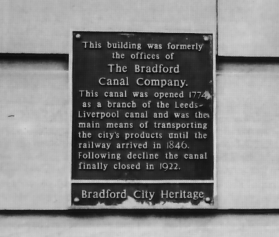
References
[The references have renumbered for this online version of the paper to facilitate the use of the within-page links.]
1. West Yorkshire Archive Service, Canal Road, Bradford (back)
2. Gary Firth, Bradford and the Industrial Revolution, Ryburn Publishing, 1990 (back)
4. Ald. Horace Hird, Bradford Remembrancer, The McDonald Book Co. Ltd., 1972 (back)
5. Wilfred Robertshaw M.A., "An Early Bradford Bank Note" Bradford Antiquary, New Series Part XXXIX, April 1958 (back)
6. Mary W. Batley, "The Earl of Rosse and the Rosse Telescope" Bradford Antiquary Third Series No.1, 1985 (back)
7. John James, History & Topography of Bradford and its Parish (With Continuations and Additions), Longman, Brown, Green & Longmans, London & Charles Stanfield, Bradford, 1840 (back)
8. Gary Firth, Bradford and the Industrial Revolution, Ryburn Publishing, 1990 (back)
10. Dr Colin Sidaway, Unpublished manuscript of The History of the Bradford Canal, c.1995 (back)
11. Gary Firth, Bradford and the Industrial Revolution, Ryburn Publishing, 1990 (back)
12. Dr Colin Sidaway, Unpublished manuscript of The History of the Bradford Canal, c.1995 (back)
13. West Yorkshire Archive Service, Canal Road, Bradford (back)
14. Ald. Horace Hird, Bradford Remembrancer, The McDonald Book Co. Ltd., 1972 (back)
15. Gary Firth, Bradford and the Industrial Revolution, Ryburn Publishing, 1990 (back)
16. West Yorkshire Archive Service, Canal Road, Bradford (back)
17. Gary Firth, Bradford and the Industrial Revolution, Ryburn Publishing, 1990 (back)
18. William Cudworth, Bolton and Bowling, Thos. Brear & Co. Bradford, 1891 (back)
20. William Cudworth, Rambles Round Horton, Arthur Dobson Pub. Co., N.d. (Reprint of 1886) (back)
21. John James, History & Topography of Bradford and its Parish (With Continuations and Additions), Longman, Brown, Green & Longmans, London & Charles Stanfield, Bradford, 1840 (back)
22. William Cudworth, Bolton and Bowling, Thos. Brear & Co. Bradford, 1891 (back)
23. Pamela Rae, Turtle at Mr Humble's, Smith, Settle (Otley), 1992 (back)
24. Gary Firth, Bradford and the Industrial Revolution, Ryburn Publishing, 1990 (back)
25. Ald. Horace Hird, Bradford Remembrancer, The McDonald Book Co. Ltd., 1972 (back)
26. William White, History; Gazetteer and Directory of the West Riding of Yorkshire, Volume I, 1837 (back)
27. Paul Langford, A Polite and Commercial People, Oxford Uni. Press, 1989 (back)
Also: An Act for Making a Navigable Cut or Canal from Bradford, to join the Leeds and Liverpool Canal at Windhill, in the Township of Idle, in the County of York. Published by Parliament 1771.
John Allison has lived all his life in Bradford. After leaving Carlton Grammar School he qualified as a work study engineer. He worked in a variety of industries and for Bradford Council until retiring in 1994. His interest in local history (being vice president and membership secretary of the Bradford Historical and Antiquarian Society) and in the English canal system (he is part owner of "URSULA" a 60' narrow boat) naturally lead him to research the history of the Bradford Canal.
© 1999, John Allison and The Bradford Antiquary

